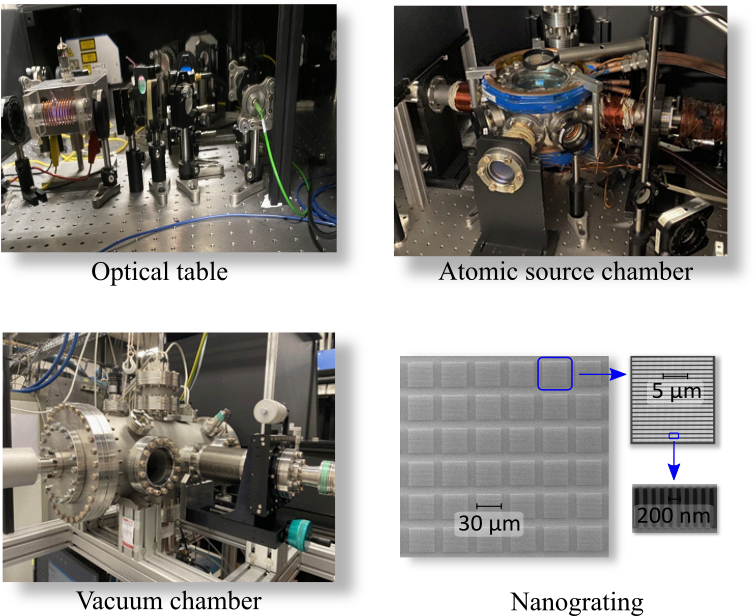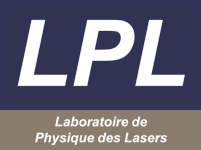Atomic diffraction through a nanograting
1) Group members:
Permanent: Gabriel Dutier (Pr.), Quentin Bouton (CR CNRS), Nathalie Fabre (MCF), Francisco Perales (MCF), Martial Ducloy (DRCE Emeritus).
PhD students: Matthieu Bruneau (cotutelle avec l’Université de Leibniz à Hanovre en Allemagne), Gabin Routier, Etienne de Girolamo
Contacts : Gabriel Dutier, Quentin Bouton, Nathalie Fabre.
2) Research context:
An atom in front of a surface is one of the simplest and fundamental problem in physics. Yet, it allows testing quantum electrodynamics, while providing platforms for the nanotechnologies and quantum technologies. In particular, the presence of electromagnetic quantum fluctuations (associated to the zero-point energy in quantum mechanics) leads to a force between an atom and a surface (macroscopic body). This force is called the Casimir-Polder (C-P) force.
Every polarizable object in nature is subjected to the C.P force. This force prevails at the nanoscopic scale, entailing its strong connections with many domains, from nanotechnology to physical chemistry. The basic understanding of this force is crucial for probing novel physics involving an atom and a material at a small relative distance.
In this context, we have built slow atomic beam interacting with a nanograting (grating featuring nanoscale dimensions such as 50-100 nm width slits, 100-200 nm period and 50-100 nm thickness for instance). The nanogratings are developed and manufactured by the team itself within the RENATECH framework at “Institut d’Electronique de Microelectronique et de Nanotechnologie” (IEMN, Lille). Passing through the nanograting, the atoms interact with the slits within the C-P interaction for atom-surface distance up to some dozen nm.
3) Experiment:
Our unique experimental set-up uses a laser-cooled Argon source in the 43P2 metastable state to create a slow atomic beam with velocity ranging from 10 m/s and 50 m/s [1]. The atoms in the beam interact with the nanograting within the C-P force. The metastable Argon atoms are then detected with an efficient time-position detection at the single atom level with microchannel plates (Figure 1). The atomic wave packet phase shift induced by the atom-surface interaction modifies the interference pattern. The diffraction spectrum is here dominated by the C.P interaction due to the large interaction time allowed by the slow velocities (the phase being proportional to the interaction time in the nanograting). It leads to a highly sensitive measurements of the C.P force (see Figure 2).
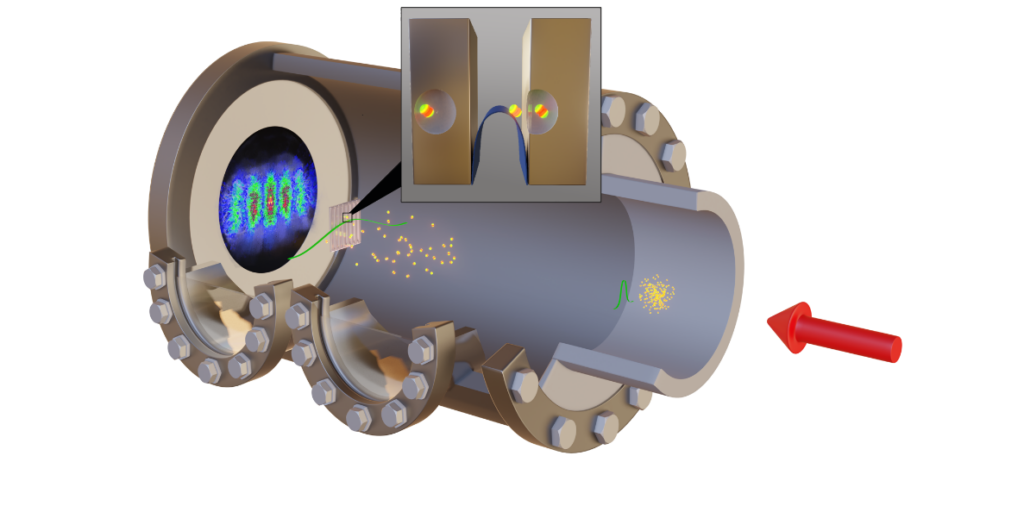
Figure 1: Sketch of the experiment. Neutral Argon atoms interact with a nanograting within the C-P potential. This interaction with the nanograting leads to a diffraction pattern. Information related to the C-P potential are extracted from the analysis of the interference pattern.
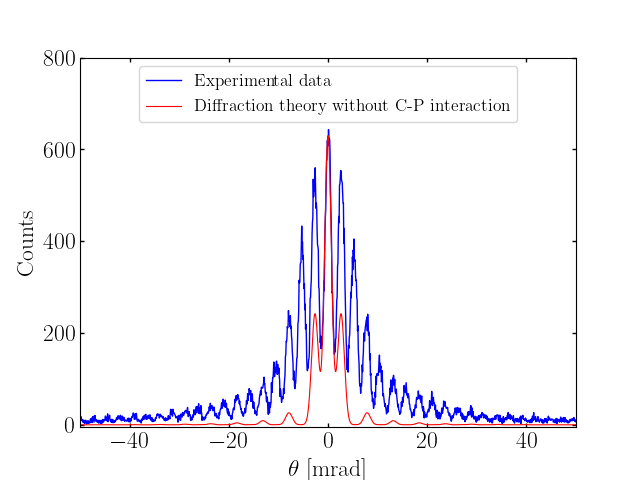
Figure 2: Experimental diffraction spectrum of metastable argon through a nanograting at 19 m/s (in blue). The angle θ is the diffraction angle. In red, theoretical curve without considering the C-P interaction. The difference between the blue and red curve underlines how strongly the diffraction spectrum is dominated by the C-P interaction.

Figure 3: This video shows single Argon atoms arriving on the microchannel plates detector during an experimental acquisition. As more and more atoms reach the detector, the full interference pattern becomes more and more visible!
4) Group picture:
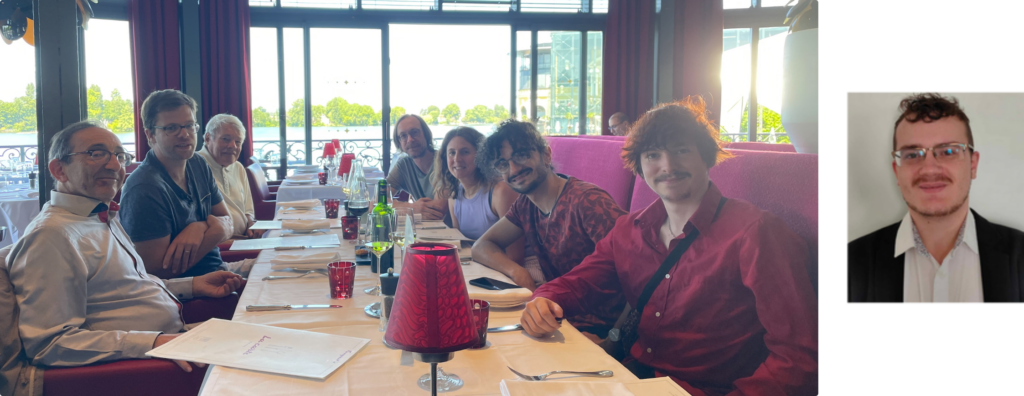
Right picture: Etienne de Girolamo.
5) Intership/PhD proposal:
We are always looking for prospective PhD students, postdocs or interns to join our group. Do not hesitate to contact one of the staff members. We are looking forward to hearing from you!
6) Recent news:
September 2025: We welcome Gabin Routier, new PhD student on the experiment! Welcome, Gabin!
August 2025: Our article “Quantum reflection effects in the diffraction of matter waves” has now been published in Europhysics Letters. A big thank you to Johannes Fiedler!
July 2025: Our article “Probing the geometry dependence of the Casimir-Polder interaction by matter-wave diffraction at a nanograting” has now been published in Europhysics Letters. Thank you very much to Thorsten Emig!
July 2025: A new preprint posted on arXiv (arXiv:2507.03055) with our collaborator Johannes Fiedler!
June 2025: Nathalie’s Q-METTEM project has been selected to perform 3D tomography of the nanogratings!
June 2025: Matthieu Bruneau won “Ma thèse en 180 secondes” at the Galilée Doctoral School! Congratulations!
May 2025: New preprint posted on arXiv (arXiv:2505.10056) with our collaborator Thorsten Emig!
April 2025: Étienne de Girolamo started an internship with our collaborator N. Gaaloul (Leibniz University Hannover, Germany) on a topic directly related to our experiment. Welcome from Germany, Étienne!
March 2025: A new intern joins the team. Welcome, Gabin!
March 2025: Our article “Measurement of Casimir-Polder interaction for slow atoms through a material grating” has now been published in Phys. Rev. Research. A big thank you to our theoretical collaborators N. Gaaloul and E. Charron.
January 2025: Julien Lecoffre successfully defended his thesis. Congratulations!
December 2024: Matthieu Buneau received an award for his poster at the “Classical and Quantum Fluctuations across Systems and Scales” conference in Bad Honnef, Germany! Well done!
November 2024: We welcome Anir Mejjaoui from the Institute of Optics for a six-month internship. Welcome!
October 2024: Our CoCoQuaT project was selected during the DIM Quantip call (ML 2024).
July 2024: we publish a new preprint where we present a method utilizing atomic diffraction patterns and statistical analysis tools to infer the Casimir-Polder interaction between Argon atoms and a silicon nitride nanograting. Read our new preprint if you are interested: arXiv:2407.14077 (2024).
July 2024: we have been awarded an ANR funding on the Ar experiment setup.
March 2024: Julien Lecoffre participates at the regional final of “Ma thèse en 180 secondes”! His video can be found here.
May 2023: our paper «Quantum description of atomic diffraction by material nanostructures» is now published in Phys. Rev. Research. Many thanks to our theory collaborator N. Gaaloul and E. Charron.
December 2023: check our new paper posted on arXiv (arXiv:2312.12818) where we present a theoretical model of matter-wave diffraction through a material nanostructure.
October 2023: we welcome Matthieu Bruneau, new PhD student in co-tutelle between our team and the University of Leibniz in Hanover in Germany. Welcome Matthieu!
7 ) Publications:
2025
- J. Lecoffre, A. Hadi, M. Bruneau, C. Garcion, N. Fabre, É. Charron, N. Gaaloul, G. Dutier, and Q. Bouton, Measurement of Casimir-Polder interaction for slow atoms through a material grating, Phys. Rev. Research 7, 013232 (2025).
- M. Bruneau, J. Lecoffre, G. Routier, N. Gaaloul, G. Dutier, Q. Bouton and T. Emig, Probing the geometry dependence of the Casimir-Polder interaction by matter-wave diffraction at a nanograting, EPL 151, 25001 (2025)
- J. Fiedler, F. Spallek, A. Vega, E. K. Osestad, Q. Bouton and G. Dutier, Quantum reflection effects in the diffraction of matter waves, EPL 151 25003 (2025).
2024
- J. Lecoffre, A. Hadi, M. Bruneau, C. Garcion, N. Fabre, E. Charron, N. Gaaloul, G. Dutier, Q. Bouton, Measurement of Casimir-Polder interaction for slow atoms through a material grating, arXiv:2407.14077 (2024).
- C. Garcion, Q. Bouton, J. Lecoffre, N. Fabre, É. Charron, G. Dutier, and N. Gaaloul, Quantum description of atomic diffraction by material nanostructures, Phys. Rev. Research 6, 023165 (2024).
2021
- C. Garcion, N. Fabre, H. Bricha, F. Perales, S. Scheel, M. Ducloy, and G. Dutier, Intermediate-Range Casimir-Polder Interaction Probed by High-Order Slow Atom Diffraction, Phys. Rev. Lett. 127, 170402 (2021).
8) Collaborations:
- – Thorsten Emig (Paris-Saclay university)
- – Johannes Fiedler (Bergen university, Norway)
- – Stefan Yoshi Buhmann (Kassel university, Germany)
- – Institut d’Electronique de Microelectronique et de Nanotechnologie (Lille, France).
- – N. Gaaloul (University of Leibniz in Hanover, Germany).
- – E. Charron (University Paris-Saclay, Institut des Sciences Moléculaires d’Orsay, France).
- – Kanu Sinha (Arizona State University).
9) Funding:
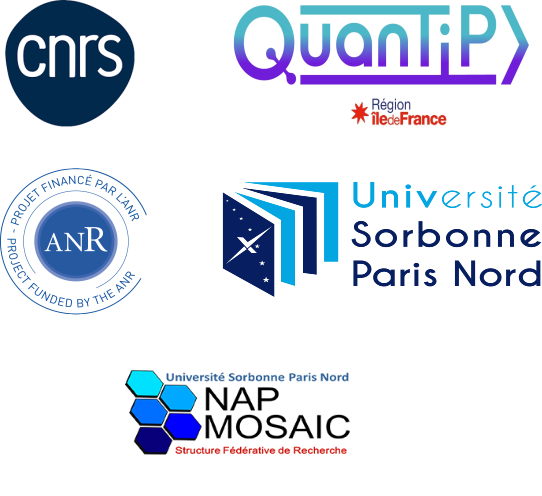
10) Former members:
- – Albert Greg (2025, Institut Sup Gallilée)
- – Hugo Lebaud (2025, Institut Sup Gallilée)
- – Anir Mejjaoui (internship 2024-2025)
- – Charles Garcion (Thèse 2019-2022)
- – Ilias Boutaleb (2023, M1, Sorbonne université)
- – Hajra Ghulam (2022, M1, Université de Paris)
- – Fabio D’ORTOLI-GALERNEAU (2022, L3, ENS)
- – Baazia Elmehdi (2022, Ingénierie en Instrumentation, Institut Sup Gallilée)
- – Hanane Bricha Tazi (thèse 2016-2019)
11) References:
[1] C. Garcion, N. Fabre, H. Bricha, F. Perales, S. Scheel, M. Ducloy, and G. Dutier, Intermediate-Range Casimir-Polder Interaction Probed by High-Order Slow Atom Diffraction, Phys. Rev. Lett. 127, 170402 (2021).
[2] J. Lecoffre, A. Hadi, M. Bruneau, C. Garcion, N. Fabre, E. Charron, N. Gaaloul, G. Dutier, Q. Bouton, Measurement of Casimir-Polder interaction for slow atoms through a material grating, arXiv:2407.14077 (2024).
[3] R. Bennett, Revealing short-range non-Newtonian gravity through Casimir–Polder shielding, New J. Phys. 21 033032 (2019).
12) Some pictures of the experiment:
